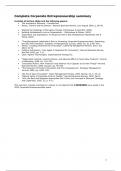Complete Corporate Entrepreneurship summary
Includes all lecture slides and the following papers:
• The Innovator’s Dilemma – Introduction
• Moore, “Darwin and the Demon,” Harvard Business Review, July-August 2004, p. 86-93.
• Meeting the Challenge of Disruptive Change (Christensen & Overdorf, 2000)
• Building Ambidexterity into an Organization – (Birkinshaw & Gibson, 2004)
• Exploration and Exploitation: An Empirical Test of the Ambidexterity Hypothesis (He &
Wong, 2004)
• “Transformational Leadership’s Role in Promoting Corporate Entrepreneurship: Examining
the CEO-TMT Interface,” Academy of Management Journal, 2008, Vol. 51 p.557-576.
• Manso, “Creating Incentives for Innovation”, California Management Review, 2017, Vol.
60(1) 18-32.
• Podolny and Hansen, “How Apple is Organized for Innovation”, Harvard Business Review,
Nov/Dec 2020, pp. 1-11.
• Case: Agilent Technologies: Organizational Change (A).
• “Stage-Gate Controls, Learning Failure, and Adverse Effect on Novel New Products”, Journal
of Marketing, 2008. Pp. 118-134.
• “Innovation Killers: How Financial Tools Destroy Your Capacity to Do New Things” Harvard
Business Review, 2008, January, pp. 98-105.
• “The Dynamics of Product Innovation and Firm Competences”, Strategic Management
Journal, 2002, pp. 1095-1121.
• The Era of Open Innovation”. Sloan Management Review, 2003, Spring. 44, 3, 35–41.
• “Making Sense of Corporate Venture Capital,” Harvard Business Review, 2002, March.
• “Why the Best and Brightest Approaches Don’t Solve the Innovator’s Dilemma” Strategy
and Leadership, 2005. 33, p. 4-11.
This summary includes markings (in yellow) on all subjects that I REMEMBER were asked in the
2023 Corporate Entrepreneurship exam.
1
,Lecture 1: Innovator’s Dilemma
The fall of Nokia
60% of phones used to be sold by Nokia
Was evaluated more than 50 billion and sold to Microsoft
Focus shifted from hardware to software while Nokia mainly focused on hardware
• They responded slow to trends
Large firms missing the boat
Typologies of technological change
• Old vs. new (Cooper and Schendel, 1976)
• Competence-enhancing vs. competence-destroying (Tushman and Anderson, 1986)
o Destroys essentially everything you have done before
• Incremental vs. radical (Utterback, 1994)
• Sustaining vs. disruptive (Christensen and Bower, 1996)
It is especially the latter types of change that large established firms have difficulties coping with.
Why? The Success Syndrome
1. Fit
2. Success
3. Size and age
4. Inertia (not wanting to move)
o Structural
o Cultural
5. Success in markets
6. Failure when markets shift
Structural inertia
Some of it is natural, so if I go bigger then more people will have to say something about strategy
etc. etc. The size of the organization simply makes it slower.
Cultural inertia
Firms are so convinced that what they are doing is right so it is difficult to change
o As long as the market/environment stays stable this is good
Is inertia always bad?
Not always, inertia may result from accountability and reliability.
How to protect the traditional successful business and to engage in radical
innovation at the same time?
So what do firms have to do? Look at what made them successful in the past
but also look at the future
2
, Innovator’s Dilemma
According to Clayton Christensen, failure to adapt to disruptive innovation is not the result of bad
management, but a result of good management.
Large companies depend on their existing customers and investors for resources. They listen
closely to these customers and investors and kill ideas for which there is little need.
o One of the things that can happen is that firms listen too much to their customers
(e.g., Microsoft asking if their customers want no keyboard anymore).
Innovator’s Dilemma?
Low dotted line: least demanding customer
High dotted line: most demanding customer
Position A, You are making bikes that make the low end of
the market happy, because you will learn more you will
get to B. However, at some point you are overshooting
(e.g., iPhone having 5 or 6 cameras)
At the same time there is a firm in position C. It is
currently not really working, if you do some sort of market
analysis it will also not be good, the market analysis will
say ‘do not do it’. At some point they will get to point D,
where they will get to the low line, low end of the market
and at some point even go to point E. That is the
innovator’s dilemma.
The best example for this is Nokia and Apple with the traditional phone and smartphone.
Disruptive technologies typically have (at least initially):
• Lower profit margins
• Small markets
• No reliable market statistics
Microsoft: ‘were software guys’ (see videos)
• They always did software
• So there is some sort of inertia
3





